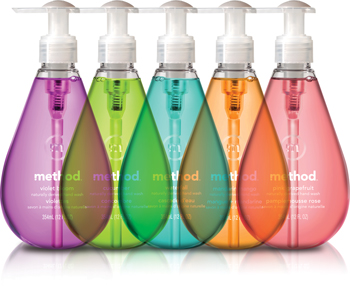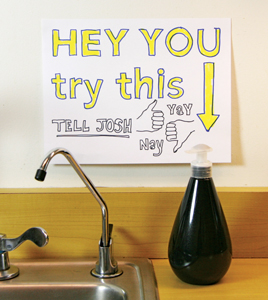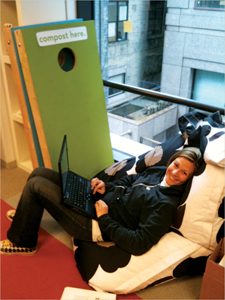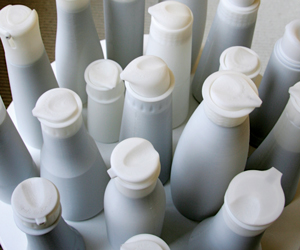
by Josh Handy, vp of industrial design, Method products
Method began in 2000 when college roommates Adam and Eric started mixing up cleaning products in empty beer pitchers in what we affectionately call the “dirtiest flat in San Francisco.” Eleven years later, we are a team of about 100 people making more than 100 cleaning products. Our story and success is based on finding new and better ways to run through the legs of our Goliath-sized competitors.
When it comes to design we "order in"
One of the most important lessons we’ve learned is that an internal design team, properly positioned, can not only kick ass creatively, but can have a powerful effect on culture and the organization’s ability to innovate. We’ve found that our “design–led” approach improves the quality and speed of our decision making, allowing us to rapidly strengthen our thinking while simultaneously building consensus across the organization.
"In-sourcing" drives brand and enterprise value
When I joined method in 2006, we stopped using external consultants and brought design and creative in-house. If we were going to reduce our time to market, be more responsive to our customers and develop more innovative products, then a much tighter integration between new product development, marketing, sales and operations would be required. We had already co-located these functions in our open-plan offices to promote better communication, but the process needed facilitation. We surmised that designers were uniquely positioned to fulfill this role. Their natural spheres of influence intersected all of these apparently disparate functional worlds.
We situated the design teams (industrial and graphic) centrally in the office, among the brand, operations, sales, engineering and product formulation teams and gave them 120 feet of floor-to-ceiling whiteboard (which we call the wiki-walls) to display their work. As the designers (and eventually everyone else) started putting their work, concepts and ideas up and making their thinking visible and explicit for all to see, people naturally began to gather around the boards and discuss the ideas, building on them, tweaking and making them better. In short, they were collaborating. No need to book a conference room next Tuesday and create a PowerPoint deck – just grab the person you want to talk to, walk over to one of the wiki-walls and chat. The effect this had on our ability to rapidly iterate ideas and build consensus across multiple stakeholders and departments cannot be overstated.
For example, one of the big challenges we face is integrating sustainability into our business practices. This is a systemic issue that requires a systemic response. In Method’s case, it’s not only about designing a recyclable bottle, but how to make it beautiful, functional and out of post-consumer recycled material; fill it with effective, non-toxic, plant-derived cleaning power; get it to the retailer with a minimal carbon footprint; then tell the story at shelf and delight the user at home. Only a fully integrated organization with open lines of communication can expect to deliver on a sustainability promise that touches so many areas. Having co-located functions in constant communication, building on each other’s ideas in short, rapid iterations, allows us to develop remarkably resolved product propositions and see opportunities across categories and functional areas.

As designers become more integrated, their business IQs increase
The benefit of having informed, well-connected, business-savvy designers is that they make better decisions in their design work that more closely align with the organizational strategies. Knowing that a certain vendor has approached us with a new technology or that a printer has a certain press configuration that has price implications, allows them to be considered up front and incorporated at the inception of the design work, then championed through by the designer.
This contextual understanding is often impossible for an external team to replicate due to the typically transactional nature of the relationship. Internal teams are also able to exert influence over intractable stakeholders or choke points in the company in an informed, business-conscious way, which still encompasses a design-led agenda. Few groups have the potential depth of exposure and, hence, the ability to influence different areas of the company as an internal design team. From research to procurement, engineering, marketing and sales, they see it all.

Designers drive strategy
When designers are exposed to the full picture of the business, their ability to think abductively makes them original and powerful product and brand strategists. While MBAs are great deductive thinkers, slicing and dicing data looking for white space, and market researchers are great inductive thinkers, probing consumers for insights, designers are skilled at imagining and expressing something that hasn’t existed before. Designers are trained to work with ill-defined problems, connecting the dots and making a leap. The more dots you give them, the more potential there is for new, robust disruptive ideas. They can take a new technology from a vendor, twist it around, connect it with a consumer insight, pair it with an existing product platform and suggest a merchandizing strategy.Two vp-level designers on the leadership team
Some of Method’s success is due to our mastery of the intangible aspects of product experience that larger, more impersonal companies find very difficult to replicate. These attributes (form, fragrance, color and experience) are the stock and trade of designers, but they can easily be rationalized away by overzealous spreadsheet use. Method, having recognized that these are key strategic assets, keeps designers in influential positions within the company to help protect them from dilution.
It’s important to note that this does not mean defending design at all costs. The by-product of a design-led organization is that everyone is cognizant of the role design plays in creating value, and this allows designers to participate in meaningful conversations without having to feel defensive. A typical debate at Method involves trading packaging attributes for sustainability. A recent debate centered on the question, “Is it better to have crystal clear bottles that make the colors of our formulas pop on shelf or bottles made from 100 percent recycled plastic that although cloudy, deepen our sustainability credentials?” It was only through the close collaboration between our designers, engineers, chemists, vendors and “greenskeepers” (our sustainability gurus) that we managed to do both.
Ask the world of your designers
When I talk about our integrated approach to professionals in the CPG industry, Method is often critiqued for having unrealistic expectations for designers, and I suppose it is true if you employ designers who are one-dimensional in their approach and training. But many aren't, and we're very rigorous in how and who we hire. For designers to advance at Method, they must work cross functionally and demonstrate influence. Collaboration, innovation and resourcefulness are part of all Method employees' performance reviews and are particularly stressed for designers, for obvious reasons.
We believe that the model of deeply integrated internal design teams will become standard practice in the future as companies continue to look for ways to outperform their competition and delight their consumers. Method has certainly benefited from this approach. BP
Josh Handy leads industrial design and innovation at Method. He has a degree in mechanical engineering, a master's in industrial design and an MBA in design management. But don't let all that fool you. He's no overeducated-design-geek-weirdo...he's a Kiwi.
